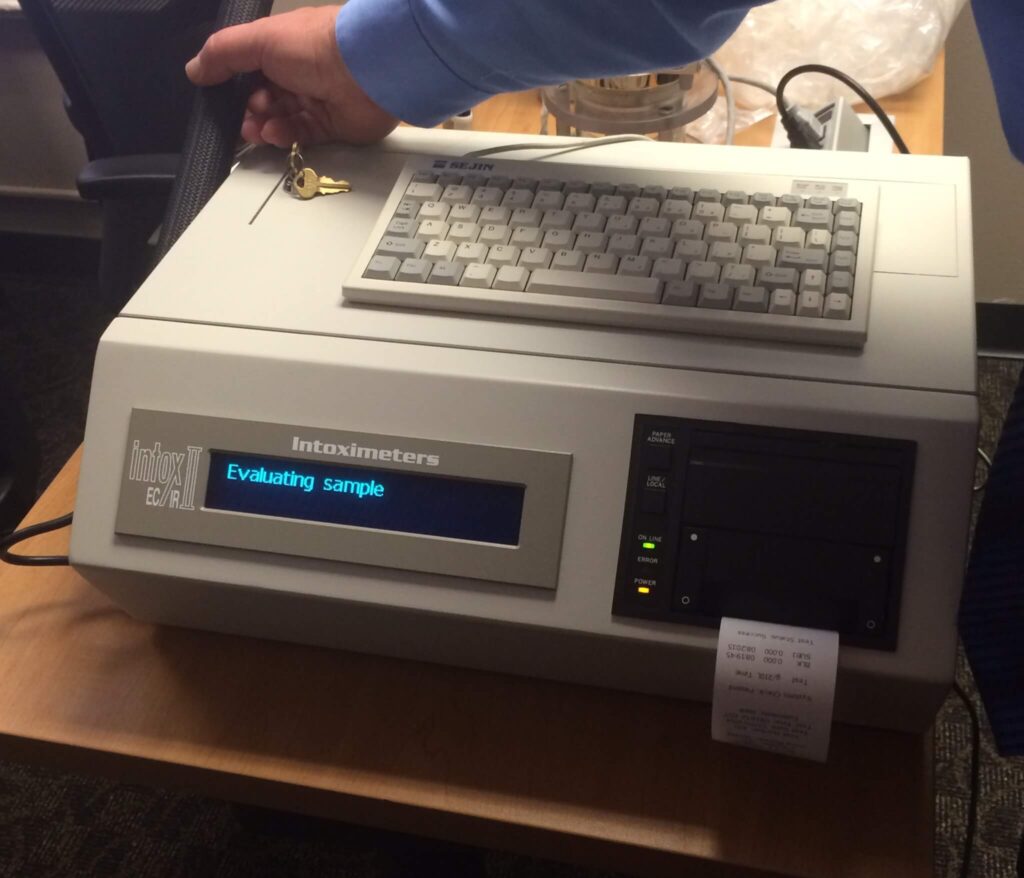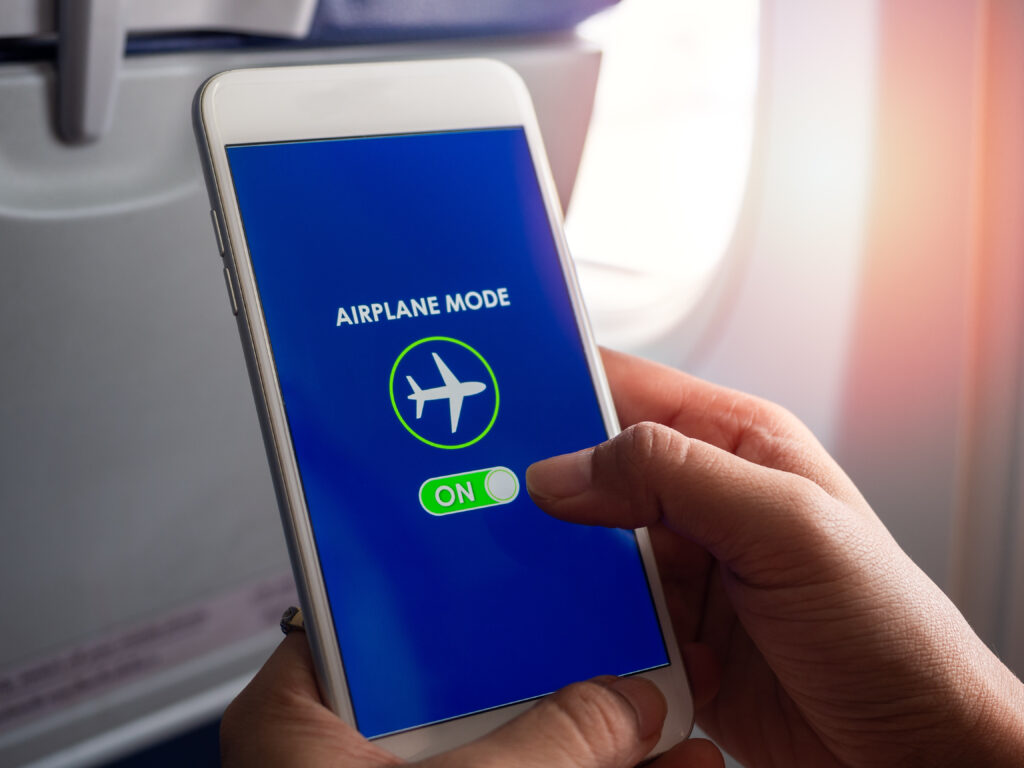The State of Indiana has two options for charging you with DUI / OVWI. On the one hand, it can claim that you drove while intoxicated. This can be shown through circumstantial evidence, including the odor of alcohol, slurred speech, unsteady balance, and “soiled” clothing.
On the other hand, the State can also charge you with operating a vehicle with a specific alcohol concentration equivalent (ACE) in your body. To succeed with the second option, the State must use a certified test to show that that your ACE was at least .08 grams of ethanol per:
- 100 milliliters of blood; or
- 210 liters of breath.
The EC/IR II
In 2014, the State of Indiana put Intoximeters’ EC/IR II breath testing machine into use. The EC stands for electrochemical, the IR stands for infrared, and the II means it’s a second generation device. Despite looking like a 1980s Apple computer, the EC/IR II represents a relatively newer model of breath testing machine.

Its manufacturers claim the EC/IR II produces reliable results because it uses two separate sources of measurement—electrochemical and infrared. All tests have problems, however, and a measurement always depends on both the instrument and the person who’s using it.
Results from an EC/IR II can be challenged using the same strategies that apply to other breath test machines. Some of the more common issues with EC/IR II tests include:
- problems detecting alcohol in the mouth;
- radio frequency interference;
- retrograde extrapolation; and
- partition ratio variation.
Let’s take a look at each of these individually.
Mouth Alcohol
Official protocol requires police to conduct a 15-minute observation period before they have a suspect provide a breath sample. During this waiting period, the test subject may not eat, drink, or put any foreign substance in their mouth.
A breath sample can be invalidated by the presence of alcohol in the subject’s mouth. This might result from either a recent burp or a chronic digestive issue like colitis or gastroesophageal reflux disease. If the EC/IR II detects alcohol in the subject’s mouth, it alerts the officer to a problem with the sample.
The Indiana Administrative Code instructs the officer to discard invalidated test results, but the story doesn’t stop there. Studies have shown that the mouth alcohol detection component is far from foolproof.
For example, imagine you’ve just burped, which increases the amount of detectable alcohol in your mouth. If the EC/IR II doesn’t invalidate your sample with a mouth alcohol error message, this will almost certainly result in an elevated reading.
This point can be illustrated with a real life incident, where a client blew .093 on their first test. This means the test revealed .093 grams of ethanol per 210 liters of breath. On the follow-up test, the client’s breath sample produced the mouth alcohol error message. On the third test, the client blew .083.
In this case, the first test clearly represented a machine error, where the EC/IR II failed to throw the proper error message and instead came back with an inflated reading. Until we develop the perfect breath test machine, this will continue to be an issue.
Radio Frequency Interference
The EC/IR II’s infrared component tests for alcohol by measuring the amount of infrared light absorbed by a breath sample. The more light that’s absorbed, the higher the alcohol level in the breath sample. This kind of measurement involves complicated electrical procedures that can be affected by radio frequency interference.

The most common source of radio frequency interference is a cell phone. This holds true regardless of whether the phone was in use at the time of the test. Today’s smartphones are constantly processing information and running background applications.
If you doubt that cell phones can cause interference with mechanical equipment, consider that airlines still require you to put your phone in airplane mode prior to take-off. The airlines aren’t trying to annoy their customers. They’re simply trying to keep smartphones from causing problems with the pilot’s instruments.
Keep in mind that this remains an issue on planes, even though airlines constantly update their interference detection equipment. The interference detectors in the EC/IR II are at least a decade old. This means that radio frequency interference will likely continue to cause problems for certified breath tests.
Retrograde Extrapolation
The EC/IR II measures a test subject’s breath sample in the moment—but what about when they were driving? How can police take an alcohol measurement at a specific time and apply it to a previous moment? How does law enforcement show that intoxication at point B in time also shows intoxication at point A?
The answer, unfortunately, is an unreliable process known as retrograde extrapolation. This allows police to make an estimate about the subject’s previous alcohol levels by projecting backwards in time.
Let’s say, for example, that you were involved in an accident at 9:00 p.m. When an officer shows up, he suspects intoxication. He places you under arrest and takes you to the station for a breath test, where you provide a sample at 10:00 p.m. that registers .07.
The average person supposedly eliminates alcohol at a rate of .015 grams per hour. Using this standard, the State will argue that if your ACE was .07 at 10:00 p.m., it must have been .085 an hour earlier. In other words, it can conclude that you were legally intoxicated at the time of the crash.
This strategy has two significant problems. First, the State always assumes that the test subject has already entered the elimination phase (sometimes called the postabsorptive phase) of alcohol consumption. Anyone who’s studied the science knows that a number of factors play a role in alcohol absorption, the most significant of which is the presence or absence of food in the stomach.
In the above example, if your body was still in the process of actively absorbing alcohol at 9:00 p.m., this would change the calculus. Your ACE at 9:00 p.m. would likely have been lower—not higher—than the EC/IR II’s 10:00 p.m. measurement of .07. Without detailed testing over a period of time, no one can truly know if a subject is actively absorbing or eliminating alcohol from their body.
Second, retrograde extrapolation estimates assume a standardized elimination rate of .015 grams of ethanol per hour. This rate is a statistical average, and it doesn’t apply to any one person. A subject’s actual elimination rate can be affected by a number of variables, including:
- sex;
- height;
- body type;
- how much water is in their system;
- how recently food has been consumed; and
- blood loss.
Serious scholars recognize retrograde extrapolation as junk science. Dr. A.W. Jones has dismissed it as “a dubious practice, owing to the many variables and unknowns involved.” The late Dr. Kurt M. Dubowski likewise observed that retrograde extrapolation is “always of uncertain validity and, therefore, forensically unacceptable.”
Partition Ratio
We’ve already seen that much of the “science” that goes into certified breath tests is based on normative expectations and statistical assumptions. This remains true when it comes to the topic of partition ratio, where the EC/IR II applies a conversion ratio of 2100-to-1 to every test subject.
What does this mean? The EC/IR II assumes that the person providing a breath sample has a partition ratio of 2100 parts blood to 1 part breath. That is, if a person has 2100 parts ethanol in the blood, they have one part ethanol in the breath. Assuming that every test subject has a uniform partition ratio may simplify things on the front end, but it leads to avoidable errors.
If a test subject’s actual partition ratio differs significantly from the assumed 2100-to-1, the EC/IR II will return inaccurate results. In fact, the lower a person’s actual partition ratio, the greater the EC/IR II will overestimate their ACE. The State could address this problem by compensating for the variable, but it doesn’t.
For example, the General Assembly could pass a law calling for blood draws in close-call cases. This would mean seeking a follow-up test in cases where the breath test result is within . 02 of the legal limit for intoxication. Unfortunately, Indiana has no plans for such a law.
In such cases, the State could opt for greater precision, but again, it doesn’t. Rather than order follow-up tests to see if someone who’s blown near the legal limit is actually intoxicated, the police prefer to make the arrest and let the courts sort it out. If you find yourself suspected of DUI / OVWI, you should not expect to receive the benefit of the doubt.
Likewise, if you end up charged, don’t expect the State to conduct a thorough investigation into the machine they’re using to convict you. All the State needs to show is:
- that the officer who administered the certified breath test had been properly trained or re-trained on the EC/IR II within the previous two years; and
- that the EC/IR II machine in question had passed a routine maintenance inspection conducted by the Department of Toxicology within the previous 180 days.
The State is not obligated to and in fact will not volunteer information about the EC/IR II’s prior error messages, instances of malfunction, records of irregular calibration, or any other ongoing issues.
These kinds of things will only be uncovered by an experienced and diligent defense attorney. If you or a loved one has been arrested for DUI / OVWI, send Attorney Marc Lopez an email or give him a call at 317-632-3642, and remember—always plead the 5th!



